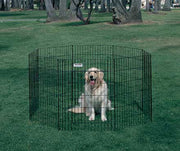Fall & Winter Dog Walking Safety Tips

Cool, fall weather is always a nice change from the muggy summer heat. As the seasons change, it's important that you keep up with your dog's daily walks. However, you may need to change your routine up a little bit in order to account for changing weather conditions.
Here are some ways you can adjust your walks accordingly, as well as some winter walking safety tips for both you and your dog.
WEAR BRIGHT CLOTHING.
Anytime you go walking at night (or when it's dark), you should make sure that both you and your dog are wearing at least one item of brightly colored clothing or something with reflective material. In many places, the sun rises later and sets earlier, meaning that if you spend most of your day at work, you'll likely be walking your dog in the dark. It's important both of you are wearing something that will allow cars and others to see you when it's dark out.
In addition to bright clothing, glow-in-the-dark or reflective clothing is a good option. Reflective tape can be purchased and applied to any article of clothing to help enhance visibility. Glow-in-the-dark leashes, collars (like this Aspen Pet Glow-in-the-Dark Dog Collar), and harnesses can be a great way for your dog to stay visible to anyone passing by. Bringing a flashlight or wearing a headlamp is also a good idea when walking at night.
WATCH OUT FOR WILDLIFE AND PESTS.
Depending on where you live, certain types of wildlife are more active as they prepare for winter. Small mammals, such as squirrels and rabbits, may be busy and scampering around, causing your dog to be curious. Make sure you're always keeping a firm hold of their leash so that they don't take off chasing anything.
Bugs and pests might also be more present in the fall, specifically fleas, ticks, hornets, and wasps. Some vets might prescribe treatments to prevent fleas and ticks. Combing and bathing your dog regularly will help you catch fleas and ticks before they get out of hand or cause your pet any illnesses. If you happen to notice a tick on your dog, use this guide to help you remove it properly.
Snakes love to hide out in moist, dark areas, such as under leaves. Not all snakes are dangerous, but some, such as rattlesnakes and coral snakes, can be venomous. Be aware of your surroundings by looking up which, if any, snakes are endemic to your area, the signs to look for, and steer clear if you happen to come across any while on your walk.
For example, if you find that rattlesnakes tend to be a problem in your area during the fall, it's recommended to familiarize yourself with the rattling warning they give off. Hint: it sounds like a lawn sprinkler.
KEEP AN EYE OUT FOR MUSHROOMS.
Mushrooms are more likely to be more present in cooler weather, especially in places that are damp. Many types of mushrooms are deadly if ingested, and others may still make your dog severely ill. You don't want to take any chances, so it's best to keep watch for any mushrooms that may be growing along the trail and help your dog steer clear of them. Keep your yard clear of mushrooms by regularly checking for them and pulling them out.
If you think your dog may have consumed any wild mushrooms, take them to the vet immediately. Take a picture of the mushroom in question if possible.
STAY STREET SMART.

You should always be walking against traffic when you're walking along a street. You should also avoid busy streets whenever possible and opt for places that are quieter and less crowded.
It's always smart to plan your route ahead of time so you can stick to a schedule, avoid getting lost or avoid wandering into areas that might not be safe. Always be sure your phone is charged before you head out and don't forget to bring it along with you. You never know if you might need it in case of an emergency.
MAKE SURE YOUR DOG'S IDs AND TAGS ARE UP TO DATE.
Last but not least, it's important to be sure that all of your dog's information on his tag and other forms of ID is up to date with your current address and contact information, even if your dog is microchipped. In the event that your dog gets lost or escapes, updated identification maximizes the chances that your dog will be found and returned to you.
CONCLUSION
Just because the weather changes doesn't mean your dog's daily walks have to come to a halt. Even though it gets darker earlier, following these safety tips will ensure your and your dog's safety. Stay safe and have fun out on your walks together this fall and winter!
Previous article

Next article

Related posts
View all-

Wet Vs. Dry Cat Food: Which is Better?
As a caring cat owner, you always want the best for your furry friend, especially with their food. You typically have two choices: dry cat food in a bag or canned wet food. Whether you've just brought home a new kitty or are looking to transition to a new food, the decision process can be overwhelming, and understanding the impact of each on your cat's diet is essential. Read Article -

Celebrate National Pet Week: Fun Ideas to Celebrate with Your Pet
National Pet Week is right around the corner, so it's time to plan how you're going to celebrate! While we're sure you celebrate your pet all day every day... Read Article -

5 Simple Tips to Make Sure Your Cat Drinks Enough Water
Ensuring your cat stays hydrated is important, but it can be challenging since many cats don't drink enough water. Dehydration can lead to kidney disease and other health issues. Fortunately, you can encourage your cat to drink more with a few simple changes. Read Article



